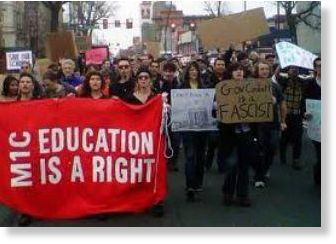
© unknown
Students from colleges and high schools around the country gathered Thursday for protests and rallies called the National Day of Action for Education.
Two groups associated with the Occupy movement -- Occupy Colleges and Occupy Education -- organized the event, along with a group called the New York Student Aid Alliance.
Natalia Abrams, an organizer with Occupy Colleges, said that more than 70 schools pledged through the Occupy Colleges website to send at least 100 students each to the rallies, with some schools pledging hundreds more. She estimated turnout to be in the "mid to high thousands."
The event is the second in two days that has drawn attention to what might be described as a second wave of the Occupy movement.
Call it Occupy 2.0. After evictions ended the movement's camping phase a few months ago, the occupation went into hibernation. Activists regrouped and got more organized, focusing on specific issues. Wednesday's march targeted the American Legislative Exchange Council, an organization that promotes policies intended to benefit corporations. Thursday's took aim at the high cost of education.
Compared with the novel spectacle of tent cities that rallied protesters and the media five months ago, this week's events haven't received much attention. Without people camping in public places, the movement isn't quite as conducive to photo ops and headlines. But if it has come to resemble a more traditional protest movement, many Occupy activists say that's a good thing.
Daniel Jones, a sophomore at New York University with years of experience in activism, said that when the movement started he was "really, really critical."
"There was a real lack of strategy and analysis and in a lot of ways the occupations were alienating huge sections of the working class," he said.
These days, said Jones, the movement isn't just about "going out there and saying inequality is bad. Now we're organizing, which means thinking about, well, where does that inequality come from? What is it we're up against? What are the sources of their power? How do we start addressing it? Those weren't conversations that were happening a month ago."
Occupy Colleges started in early October with a student walkout that attracted more than 8,000 participants around the country, according to the organizers. After a pepper-spraying incident at University of California, Davis made headlines in November, the group coordinated solidarity protests at 70 schools around the country. It also encouraged students to set up Occupy camps on their campuses, and many heeded the call. But by early January, most of the tents were down.
The average student debt in the U.S. is $24,000, under-employment among college graduates is 24 percent, and the cost of a college education has gone up by 66 percent in the last 20 years. (The last figure has been adjusted for inflation.)
Source: The Huffington Post

Reader Comments